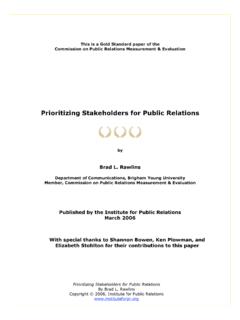Transcription of Prioritizing - Government Finance Officers Association
1 PrioritizingBy GARy DONALDSONC apital Improvement PlanningAugust 2015 | Government Finance Review 19 The nation s backlog of infrastructure construction and repairs, which was last estimated at $ trillion, is a primary challenge for state and local governments. roads, streets, bridges, and fixed assets are critical compo-nents of future economic development and growth. Tangible and intangible benefits (such as individual and institutional confidence in a Government s infrastructure capacity and return on investment) are important considerations in the deliberation and formulation of a well-planned and priori-tized capital improvement program (CIP). The improved economy has allowed state and local gov-ernments to proceed with greater confidence in initiating CIPs.
2 The prioritization of capital projects has taken on addi-tional importance, given the limited availability of financial resources to meet the competing interests for infrastructure The importance of developing and annually updating a multi-year CIP cannot be overstated. As noted in GFOA s best practice guidelines, CIPs should be updated at regular intervals, generally corresponding with the gov-ernment s annual budget process. OVERSIGhT COMMITTEESThe question of which projects get funded first when they are all impor-tant can be answered by a CIP oversight committee, which adds additional governance, structure, and accountability. (See Exhibit 1.) The composition of the oversight committee generally includes representation from the executive and legislative branches, neighborhood and citizen groups, public works engineers, project managers, and Finance Officers .
3 Regular standing meetings that are aligned with the Government s fiscal year provide the framework for the iterative steps that follow. These steps should lead to the authorization of projects to be funded in the capital budget and any related operating budget requirements. The reporting and monitoring step is required for post-budget adoption. Larger governments can deploy a two-tiered approach that acts as a filtering stage for project evaluation and rank-ing. Tier 1 consists of the director level or agency head, and the executive and legislative branches. Tier 2 consists of the level just below director and agency head, and includes neighborhood and citizen groups. Tier 2 would provide Tier 1 members with key analysis and reporting, as shown in Exhibit 1.
4 The Tier 1 group would then provide final approval through the executive and legislative branches. The monitor-ing component includes budget review as opposed to actu-ally managing cost, implementing the project and adhering to timelines, and reporting regularly to the executive and legislative branches. Monitoring and successfully executing the budget after it passes (including making sure projects are completed on time) help build stakeholder Exhibit 1 shows, the process entails updating exist-ing CIP projects and submitting new projects. Including cost-benefits analyses and business cases is an important part of the decision-making process, as well as providing a level of fiscal discipline for the Government and participants as they communicate to stakeholders.
5 Return on investment (ROI) metrics provide an objective measure for determin-ing and distinguishing the importance of a project. There are, however, capital projects that do not lend them-selves to only ROI or quantitative all capital projects have been vetted by the oversight committee, they flow to the prioritization matrix, which provides structure, objectivity, and a multi-dimensional approach to ranking capital improvement projects. The matrix tool helps with achieving consensus among a diverse group by mitigating the subjectivity in the decision-making process while Prioritizing complex issues. These matrices range in complexity from simple Excel-based programs to more complex templates offered as part of CIP software.
6 However intricate the matrix used, one of its most important components of is the list of criteria that have been agreed upon for rating projects. Exhibit 2 illustrates a criteria template and set of questions that governments can ask in the prioritization process. roads, streets, bridges, and fixed assets are critical components of future economic development and Improvement Planning 20 Government Finance Review | August 2015 Exhibit 3 illustrates an expanded set of criteria for govern-ments to consider for inclusion in their matrix. This matrix, provided by the White Bear Township, Minnesota, Finance Department, includes the project name, priority ranking, project type, useful life, and department/agency of purview. The matrix includes a line for revenues, expenditures, and operating budget impact.
7 This example comprises 15 criteria and a weighting factor for each. The weighting factor is then Exhibit 2: Criteria Template and Questions for the Deliberative ProcessCriteria Description Rating Scale (1-9)Project Requirements Is the project required to meet 1 = not required or mandated legal, compliance, or regulatory mandates? 5 = pending requirement 9 = required or mandatedStrategic Alignment To what extent is the project aligned 1 = no alignment with strategies with the Government s overall strategies? 5 = partial alignment with strategies 9 = full alignment with strategiesValue to Citizens How much value will the outcome 1 = minimal value of this project bring to our citizens? 5 = partial value 9 = high valueExhibit 1: CIP Committee Process OverviewDefine and Submit New ProjectsCost Benefit AnalysisRevise CIPU pdate Data of Existing CIP ProjectsUpdate Evaluation of Existing CIP ProjectsPrioritization MatrixAuthorize and Fund ProjectsOperating BudgetCapital BudgetFinancing PlanReporting and MonitoringBusiness Case Assessment and EvaluationA centralized agency-level process replaces decentralized 2015 | Government Finance Review 21multiplied by the priority factor to determine the overall score.
8 This particular matrix is straightforward, cost-effective, and provides an expedient means of ranking capital projects. The capital projects to be included in the revised CIP must then be aligned with viable sources of income as part of the financing plan. Identifying viable funding sources is a major Exhibit 3: Expanded Matrix Criteria Project Name: Priority Ranking: Project Type: Useful Life: Responsible Department: Project Description and Justification: Expenditures 2014 2015 2016 2017 2018 Total Revenues 2014 2015 2016 2017 2018 Total Operational Impact /Other Comments.
9 Operating Budget Impact 2014 2015 2016 2017 2018 Priority Ranking Criteria Weighting Factor Priority Factor ScorePublic Health and Safety Health and Safety Mandate Problems of Funding of Project Revenue Cost Savings Operation Costs or Condition of Existing Benefit Demand with Other Projects Goal Plan Component ScoreSource: The White Bear Township, Minnesota, Finance Department. 22 Government Finance Review | August 2015factor in the process of determining and ranking capital projects. The matrix in Exhibit 3 assigns a weighting factor of 1 to availability of funding.
10 An example of a proposed project being ranked higher than existing proj-ects would be one that is eligible for federal or state grant funding due to a viable and imminent funding award. In this example, however, the govern-ment would need to acknowledge the local match and any future recurring costs that could be increased such as personnel, operations, and maintenance costs after the sunset period. Additionally, many capital projects can be supported by a user fee or a tax on a commodity group ( , motor fuel tax that correlates to the beneficiaries of that asset). When align-ing sources and uses, the exportability of an income source is important, or the Government s ability to Finance its costs through external means for example, a convention or tour-ist jurisdiction can levy a lodging tax to pay for related capital improvements.


















